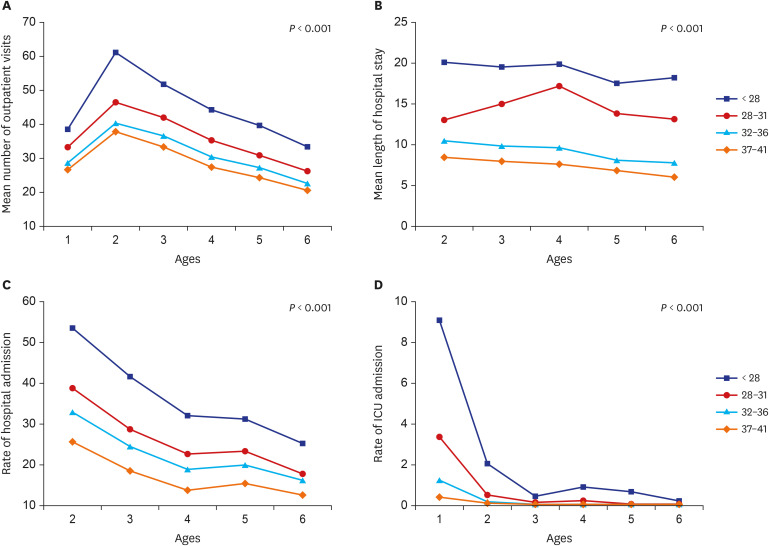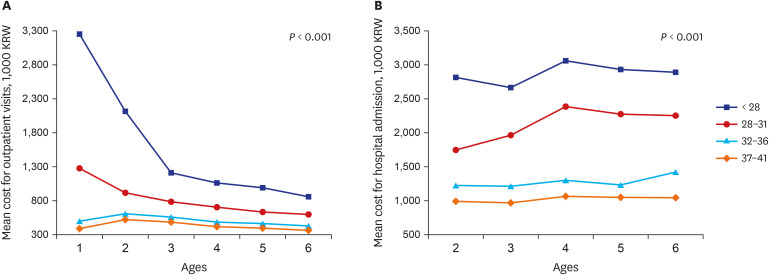J Korean Med Sci.
2022 Mar;37(12):e93. 10.3346/jkms.2022.37.e93.
Medical Utilization and Costs in Preterm Infants in the First 6 Years of Life After Discharge From Neonatal Intensive Care Unit: A Nationwide Population-Based Study in Korea
- Affiliations
-
- 1Department of Pediatrics, National Health Insurance Service Ilsan Hospital, Goyang, Korea
- 2Big DATA Strategy Department, National Health Insurance Service, Wonju, Korea
- KMID: 2527634
- DOI: http://doi.org/10.3346/jkms.2022.37.e93
Abstract
- Background
The improvement in the survival rate of preterm infants has paradoxically raised the risk of morbidities in childhood. Our objectives were to assess the medical utilization and costs in preterm infants following discharge from the neonatal intensive care unit in the first 6 years of life.
Methods
We conducted a population-based study using the National Health Information Database (2011–2017) provided by the Korean National Health Insurance Service (NHIS). A total of 361,190 children born in Korea between January 1 and December 31, 2011 were divided into four groups according to the gestational age at birth: extremely preterm (less than 28 weeks), very preterm (28–31 weeks), moderate to late preterm (32–36 weeks), and full term (37–41 weeks). The cumulative number of outpatient visits, cumulative length of hospital stay, rate of hospital and intensive care unit admissions, and cumulative medical costs for inpatients and outpatients were compared for each gestational age group.
Results
Earlier gestational age was significantly associated with an increased risk of the cumulative number of outpatient visits, cumulative length of hospital stay, and rate of hospital and intensive care unit admissions for the first 6 years of life. The mean cumulative inpatient and outpatient costs per child significantly decreased with increasing gestational age. When assessed based on population size, the total cumulative medical costs were highest for moderate to late preterm children.
Conclusion
Earlier gestational age was strongly associated with increased healthcare resource utilization and medical costs. Our findings on the potential long-term socioeconomic impact on public health are expected to aid the development of future health care policies for preterm children.
Keyword
Figure
Reference
-
1. Korean Statistical Information Service. Live births by sex, period of pregnancy of provinces. Updated 2021. Accessed October 19, 2021. https://kosis.kr/eng/statisticsList/statisticsListIndex.do?menuId=M_01_01&vwcd=MT_ETITLE&parmTabId=M_01_01&statId=1994044&themaId=#SelectStatsBoxDiv .2. Glass HC, Costarino AT, Stayer SA, Brett CM, Cladis F, Davis PJ. Outcomes for extremely premature infants. Anesth Analg. 2015; 120(6):1337–1351. PMID: 25988638.3. The Executive Committee of Korean Neonatal Network. 2019 Korean Neonatal Network Annual Report. Cheongwon, Korea: Korea National Institute of Health;2021.4. McCormick MC, Litt JS, Smith VC, Zupancic JA. Prematurity: an overview and public health implications. Annu Rev Public Health. 2011; 32(1):367–379. PMID: 21219170.5. Serenius F, Källén K, Blennow M, Ewald U, Fellman V, Holmström G, et al. Neurodevelopmental outcome in extremely preterm infants at 2.5 years after active perinatal care in Sweden. JAMA. 2013; 309(17):1810–1820. PMID: 23632725.6. Lee JH, Noh OK, Chang YS. Korean Neonatal Network. Korean Neonatal network. Neonatal outcomes of very low birth weight infants in Korean Neonatal Network from 2013 to 2016. J Korean Med Sci. 2019; 34(5):e40. PMID: 30718992.7. Talge NM, Holzman C, Wang J, Lucia V, Gardiner J, Breslau N. Late-preterm birth and its association with cognitive and socioemotional outcomes at 6 years of age. Pediatrics. 2010; 126(6):1124–1131. PMID: 21098151.8. van Baar AL, Vermaas J, Knots E, de Kleine MJ, Soons P. Functioning at school age of moderately preterm children born at 32 to 36 weeks’ gestational age. Pediatrics. 2009; 124(1):251–257. PMID: 19564307.9. Moster D, Lie RT, Markestad T. Long-term medical and social consequences of preterm birth. N Engl J Med. 2008; 359(3):262–273. PMID: 18635431.10. Lindström K, Winbladh B, Haglund B, Hjern A. Preterm infants as young adults: a Swedish national cohort study. Pediatrics. 2007; 120(1):70–77. PMID: 17606563.11. Lakshmanan A, Agni M, Lieu T, Fleegler E, Kipke M, Friedlich PS, et al. The impact of preterm birth <37 weeks on parents and families: a cross-sectional study in the 2 years after discharge from the neonatal intensive care unit. Health Qual Life Outcomes. 2017; 15(1):38. PMID: 28209168.12. Lee YH, Han K, Ko SH, Ko KS, Lee KU. Taskforce Team of Diabetes Fact Sheet of the Korean Diabetes Association. Data analytic process of a nationwide population-based study using national health information database established by national health insurance service. Diabetes Metab J. 2016; 40(1):79–82. PMID: 26912157.13. Gong KY. Modularization of Korea’s Development Experience: The Empirical Review of National Health Insurance in Korea. 1st ed. Sejong, Korea: KDI School Pub Pol Manage;2014.14. Seong SC, Kim YY, Khang YH, Heon Park J, Kang HJ, Lee H, et al. Data resource profile: the national health information database of the national health insurance service in South Korea. Int J Epidemiol. 2017; 46(3):799–800. PMID: 27794523.15. Kim BI, Lee WR, Kim YK, Park SY. The Analysis of Medical Support Systems and Effectiveness for Preterm Infants. Final Report. Report No.: 11-1352000-001845-01. Seoul, Korea: Division of Population Policy, Office of Ministry of Health and Welfare;2016.16. Boyle EM, Poulsen G, Field DJ, Kurinczuk JJ, Wolke D, Alfirevic Z, et al. Effects of gestational age at birth on health outcomes at 3 and 5 years of age: population based cohort study. BMJ. 2012; 344:e896. PMID: 22381676.17. Stephens AS, Lain SJ, Roberts CL, Bowen JR, Nassar N. Survival, hospitalization, and acute-care costs of very and moderate preterm infants in the first 6 years of life: a population-based study. J Pediatr. 2016; 169:61–68.e3. PMID: 26561378.18. Jo HS, Cho KH, Cho SI, Song ES, Kim BI. Recent changes in the incidence of bronchopulmonary dysplasia among very-low-birth-weight infants in Korea. J Korean Med Sci. 2015; 30(Suppl 1):S81–S87. PMID: 26566362.19. Townsi N, Laing IA, Hall GL, Simpson SJ. The impact of respiratory viruses on lung health after preterm birth. Eur Clin Respir J. 2018; 5(1):1487214. PMID: 30128088.20. Trembath A, Laughon MM. Predictors of bronchopulmonary dysplasia. Clin Perinatol. 2012; 39(3):585–601. PMID: 22954271.21. Johnston KM, Gooch K, Korol E, Vo P, Eyawo O, Bradt P, et al. The economic burden of prematurity in Canada. BMC Pediatr. 2014; 14(1):93. PMID: 24708755.22. Mangham LJ, Petrou S, Doyle LW, Draper ES, Marlow N. The cost of preterm birth throughout childhood in England and Wales. Pediatrics. 2009; 123(2):e312–e327. PMID: 19171583.23. Beam AL, Fried I, Palmer N, Agniel D, Brat G, Fox K, et al. Estimates of healthcare spending for preterm and low-birthweight infants in a commercially insured population: 2008–2016. J Perinatol. 2020; 40(7):1091–1099. PMID: 32103158.24. Johnson S, Marlow N. Early and long-term outcome of infants born extremely preterm. Arch Dis Child. 2017; 102(1):97–102. PMID: 27512082.25. Natarajan G, Shankaran S. Short- and long-term outcomes of moderate and late preterm infants. Am J Perinatol. 2016; 33(3):305–317. PMID: 26788789.26. Russell RB, Green NS, Steiner CA, Meikle S, Howse JL, Poschman K, et al. Cost of hospitalization for preterm and low birth weight infants in the United States. Pediatrics. 2007; 120(1):e1–e9. PMID: 17606536.27. Jin JH, Yoon SW, Song J, Kim SW, Chung HJ. Long-term cognitive, executive, and behavioral outcomes of moderate and late preterm at school age. Clin Exp Pediatr. 2020; 63(6):219–225. PMID: 32024339.28. Crump C. An overview of adult health outcomes after preterm birth. Early Hum Dev. 2020; 150:105187. PMID: 32948365.
- Full Text Links
- Actions
-
Cited
- CITED
-
- Close
- Share
- Similar articles
-
- The Clinical Features Based on Different Weight Percentile in Appropriate for Gestational Age Preterm Infants
- A Descriptive Study of Incarcerated Inguinal Hernia in Preterm Infants in Neonatal Intensive Care Units: A 10-Year Single-Center Experience
- Developing the Mansoura Early Feeding Skills Assessment Scale for Preterm Infants
- Neonatal family-centered care: evidence and practice models
- Perinatal Outcome in Small for Gestational Age Versus Appropriate for Gestational Age in Preterm Infants



